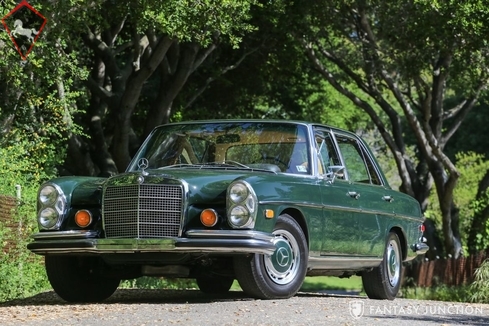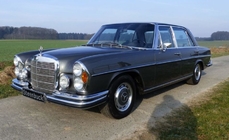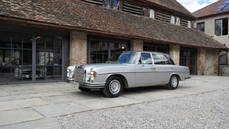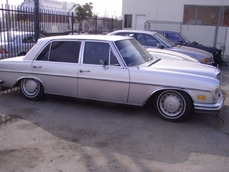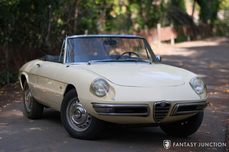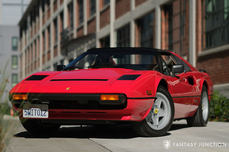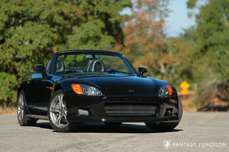Mercedes-Benz 300SEL 6.3 w109 6.3 Liter V8 1969
General description :
1969 Mercedes Benz 300SEL 6.3
s/n 109018-12-000999 eng. 100981-12-001032
Dark Olive with Bamboo Leather Interior
“Merely the greatest sedan in the world.” These words, published in the November of 1968 issue of Road & Track perfectly sum the significance and quality of the 300SEL 6.3. Simply put, there was nothing like it in terms of build quality, handling, or performance. The car has become legendary, and even the story of its creation has become something of a legend. Apparently, the engineer responsible for its creation, Erich Waxenberger created the car with no formal approval from Mercedes management, by fitting the incomparable 6.3 liter V8 from the 600 into a standard 300SEL body in place of the 3.0 liter inline-6 originally fitted to the 300SEL. He built the car after hours at the factory, working in his spare time, and also took the time to fit larger wheels and upgrade the brakes. When Rudolph Uhlenhaut, then director of Mercedes’ planning (and also the man largely responsible for Mercedes’ Silver Arrows of the 1930s and 1950s, and their GP dominance) experienced the car, he was sold. Purportedly, Uhlenhaut heard the car drive by his office and insisted to be informed what it was, and was then provided with the keys. So impressed was he with the car’s performance and manners that the car was put into production.
Today, the 6.3 remains an iconic car, one that is often credited with being the daddy of all super sedans, creating the genre that is so pervasive and enjoyable today. The specifications were impressive: 6.3 liter overhead valve fuel injected V8, power disc brakes and independent suspension all round, air suspension with adjustable ride height, safety features such as crumple zones, three-point seat belts, and padded steering wheel and dashboard. The performance was searing of course, but the car was above all a Mercedes-Benz, which meant that the car’s quality and manners were nothing short of outstanding. While American sedans were floaty, vague, and insular, the 6.3 was at once communicative, well-controlled, and supremely comfortable. And then there was the performance. With 300hp, and 434 ft/lb of torque, the car was rapid in a way that was truly shocking at the time. Indeed, the 0-60 numbers bettered the Porsche 911S and the Iso Rivolta, and equaled that of the Ferrari 330 GTC! The top end was something on the order of 140mph, and in typical German fashion, the car was perfectly happy to cruise near its top speed for hours at a time. But there was more to the car than straight line performance, as Mercedes clearly indicated by unveiling the car at Laguna Seca racetrack near Monterey, California in June of 1968. The roadholding, ride quality and brakes wowed journalists and bettered most sports cars. Road & Track went on to summarize the car by explaining that the 6.3 was “truly the executive road racer [that]…does more different things well than any other single car.” At $16,000 when a Porsche 911 cost $7200, the 6.3 was extremely expensive, and 6,526 were sold in all. Many have succumbed to rust, improper maintenance, or neglect, making properly looked after examples particularly desirable.
According to the data card and reference information supplied by the current owner, this particular 300SEL was the 999th 6.3 constructed. It was delivered new by European Motors in San Francisco on January 28, 1969 and sold to the first owner, a resident of San Francisco. Optioned with air conditioning and factory electric sunroof, the car was delivered and enjoyed by single family California ownership for 45 years, according to the current owner. Reference information from the factory data card and owner’s documents indicate the following coded features:
Mercedes Data:
Engine: 100981-12-001032
Transmission: 000938
291- Paint, Dark Olive
249- Interior Trim, Bamboo Leather
401- Single seats
410- electric sliding roof
461- Instrument, in English
491- U.S. Version
503- Outside rearview mirror, on the left
519- Becker radio
524- Paintcoat preservation
531- Automatic antenna
598- Heat-insulating glass
641- White-wall tires
669- Mode of packing VE IV
306- Air conditioner
Front right and left axle- 488
Rear axle- 1027
Steering box- 553
In addition to the options listed above, the car was outfitted with a later series cruise control unit (not currently functional), an aftermarket radio, and correct power antenna. The car remained in California under single family ownership until the current owner purchased it in 2014. Essentially a two-owner car, this car benefits from the remarkable combination of original condition and sensitively serviced components make for a truly special example. Under current ownership, the fuel injection pump has been recently serviced and reconditioned by Pacific Fuel Injection. Further, the valves were adjusted, the radiator removed and cleaned, and all fluids and filters replaced. The throttle linkage bushings were replaced, and rear brakes/calipers and discs as well as a new master cylinder was installed. The front and rear shocks were replaced approximately 3,500 miles ago. Among the notable original aspects of the car, the hood, fenders, doors, and trunk hinge bolts remain undisturbed. Original hood spring rubber bumpers, largely original interior, including door panels and dash, further support this truly exceptional example.
Benefitting from exceptional care and detailing throughout its life, the car presents honestly with a glossy finish and good luster throughout. The paint has a few small chips in the usual places and a small area that has been polished through above the rain gutter above the left rear door, but was done to very good standards and presents very nicely. The inner strike surfaces are in very good condition, and the door and body trim are also very good overall condition, with only minor blemishes along with some gentle aging evident in a few small areas. The years of careful ownership have served the finishes well, showing some haze and light finish aging on the bumpers, but otherwise very nice brightwork. Chrome window surrounds have light surface scratches but are quite nice aside from this. The doors shut with the exceptional Mercedes solidity, while the hood and trunk lids also show very nice panel fit, reflective of original construction and factory fitting. The thin grille bars and delicate grille mesh in particular are quite nice in fit and finish as are the headlight bezels. Both front and rear bumper rubber are in very good condition showing no excessive marks. All lenses, lighting, and glass are in very good to excellent condition with no significant chips on the windshield but light marking from road use. The wheel covers are bright and correctly finished, shod with contemporary Michelin tires. The dark olive color truly enhances the elegant Paul Bracq design, creating a striking profile against the contrasting interior.
The interior is beautifully presented, displaying largely preserved original materials, all of which display excellent fit and finish as well as great detailing. The front leather seats remain supple and firmly bolstered. The driver’s outer bolster has been retrimmed but the remaining leather is original and has been redyed. The rear seat has a small tear on the seat bottom cushion. The original door panels, taut headliner, and original interior trim panels are all in lovely original condition. The carpets are also excellent, showing no significant wear marks, tight fit, proper stitching and edge-beading, with only minor evidence of use in the driver’s footwell on the heel pad. The interior as a whole delivers a very cohesive and comforting visual presentation. The steering wheel is beautifully presented with a solid unbroken rim, correctly finished center horn pad, and a smooth chrome horn ring. The dash and dash padding are in excellent condition as are the warmly hued burled walnut wood panels throughout the car. Excellent and highly contrasting gauges, instrument trim, and well-detailed switches and various levers adorn the beautifully finished dashboard. Door panels and rear seating continue the theme of excellence with great fit and presentation. All switches, knobs, and various controls operate smoothly with excellent cosmetic presentation including the (often inoperable and difficult to repair) dash booster fan, which works as expected. The A/C system blows, but not cold. The trunk is very nicely finished with correct materials including rubber mat, spare tire, and proper tool roll with tools and jacking equipment.
Under the hood, the engine compartment and engine have been properly maintained and serviced as evidenced by the correct factory finishes and proper hardware. Clearly tended to by professionals paying close attention to correct Mercedes-Benz parts and service guidelines, the engine has been detailed properly and correctly appointed. Even the unrestored finishes within the engine and engine compartment present a very honest combination of original features and properly maintained components. The undercarriage and chassis components are well maintained, clean and properly presented, representing the originality of the car. The There is no evidence of structural compromise evident when visually inspecting the undercarriage and the condition of the chassis is exceptionally nice, being extremely clean and solid throughout.
Entering the car, one is immediately aware of the easy entry as well as the seating position. Glass is expansive, offering panoramic views in all directions, enhanced by the power sunroof, drawn back to give the car even a more impressive engagement with the outdoors. The car starts easily, delivering an idle that is both civilized and slightly raucous, hinting at the more than 400 ft-lb of torque from the 6.3 liter engine. Driving manners are composed and comfortable under general conditions, and hilariously ebullient when the driver becomes more exuberant. The automatic transmission shifts positively, as though to suggest that it is a very substantial piece of engineering that is up to the task of handling the massive torque generated by the engine. Brakes track evenly and the air suspension is well balanced with negligible bleed down and a creamy, civilized ride. Mechanically, the car performs as one might expect from a properly sorted Mercedes-Benz, until entering the highway. With a gentle push on the gas pedal, the transmission quietly kicks down as a wonderful surge of progressive and ample power unleashes impressive acceleration. Highway speeds come up quickly, but composure is just as remarkable even as the car settles into final drive, with plenty more power on tap, accompanied always by a fabulous V8 soundtrack. When leisurely touring, the effortless progress, easy handling, and confident braking reveal nothing of the potential performance capability this 6.3 can deliver. The car is offered with a copious number of factory literature items including the owner’s manual, AC manual, service and warranty policy booklet, service booklets, radio manual, seat belt use guide, electrical schematic, and jacking instructions card. The car is also accompanied by tools, jacking equipment, as well as records for services performed both recently and under previous family ownership.
Understandably collectable due to their rarity, elegance, and breathtaking performance, astute collectors seeking a vintage experience they can share with family and friends, are welcoming the 6.3 as a wonderful offering. Not only remarkable for what the car is capable of, it is also significant because it was one of the original trailblazers of a formula that has become a necessity for world-class marques: the fast, luxurious sedan. Yet unlike today’s high-performance sedans, the 6.3 is the ultimate q-ship. No massive brakes or aggressively styled aero packages were needed on the 6.3, with the only visual distinction being discreet badging on the trunk lid. This is an exceptional opportunity to acquire of one of the finest luxury cars built by Mercedes-Benz, further enhanced by the amazing V8 engine, electric sunroof, and beautiful color combination. Beautifully presented and ready for enjoyable touring, this long-term California family Mercedes-Benz 300SEL 6.3 will transport delighted passengers and driver with incomparable style and surprising performance with every enjoyable mile.
https://fantasyjunction.com/inventory/1969-mercedes-benz-300-sel-6-3/overview
1969 Mercedes-Benz 300SEL 6.3 w109 6.3 Liter V8 is listed sold on ClassicDigest in Emeryville by Fantasy Junction for $48500.
Car Facts
Car type : Car Make : Mercedes-Benz Model : 300SEL 6.3 w109 Model Version : 6.3 Liter V8 Engine size : 6.3 Model Year : 1969 Location : Emeryville Vehicle Registration : Normal
Sold
Seller Information
Sold
People who viewed this Mercedes-Benz 300SEL 6.3 w109 also viewed similar Mercedes-Benz listed at ClassicDigest
Other cars listed for sale by this dealer
About Mercedes-Benz
In the annals of automotive history, the journey of Mercedes-Benz is a tale that unfolds with the ingenuity of its founding pioneers. In the year 1886, Karl Benz crafted the Benz Patent Motorwagen, a creation that would go down in history as the world's inaugural automobile. Unbeknownst to him, this moment marked the genesis of what would evolve into the most illustrious premium car manufacturer globally. The financial underpinning of this pioneering venture, interestingly, was provided by Karl Benz's wife, Bertha Benz, demonstrating a remarkable partnership that would set the tone for Mercedes-Benz's legacy.A parallel narrative emerged not far away, as Daimler-Motoren-Gesellschaft, founded by Gottlieb Daimler and Wilhelm Maybach, entered the scene. In 1901, they unveiled their automobile under the now-famous moniker "Mercedes," meaning "godsend" in Spanish. This name was bestowed upon the car at the behest of Emil Jellinek's daughter, the distributor for Daimler-Motoren-Gesellschaft. The wheels of innovation were set in motion.
Fast forward to 1926, a pivotal year that witnessed the merger of Daimler with Benz & Cie., culminating in the birth of Daimler-Benz. The amalgamation saw the adoption of "Mercedes-Benz" as the distinguished trademark for their automobiles, fusing the legacies of two visionary entities into one.
Contrary to perceptions of conservatism, the trajectory of Daimler-Benz unfolds as a chronicle of industry firsts. From the introduction of the honeycomb radiator to the float carburetor, and the pioneering implementation of four-wheel brakes in 1924, Daimler-Benz consistently pushed the boundaries of automotive innovation. The diesel-powered Mercedes-Benz 260 D in 1936 marked the inception of diesel engines in passenger cars. The iconic Mercedes-Benz 300SL Gullwing made history as the first car with direct fuel injection, albeit the Gutbrod's tiny 2-stroke engine can claim precedence.
Safety innovations became a hallmark, with Béla Barényi's patented safety cell design in the "Ponton"-models in 1951, featuring front and rear crumple zones. The W116 450SEL 6.9 saw the introduction of the Anti-Lock Brake system (ABS), another pioneering safety feature. From the first production airbags and beyond, the legacy of "firsts" continued to be etched into the fabric of Daimler-Benz.
Over its centennial journey, Mercedes-Benz has not merely produced cars but has sculpted automotive icons. The SSKL, 710 SSK Trossi Roadster, 770K Grosser, 540K Spezial Roadster, 300SL Gullwing, w100 600 Pullman, w111 280SE 3.5 Flachkühler, w113 230SL Pagoda, w109 300 SEL 6.3, and w201 2.3-16 Cosworth stand testament to the brand's commitment to engineering excellence.
The roaring Silver Arrows, or "Silberpfeile," including the W 25, W 125, W154, W165, and W196, created a legacy of dominance on the racetrack. These machines were not merely cars; they were expressions of precision, speed, and an indomitable spirit that left their competitors in the dust.
As Mercedes-Benz marches into the future, it does so not just as an automaker but as a custodian of a legacy, a torchbearer of innovation, and a beacon of automotive excellence. The road ahead is sure to witness the continued fusion of cutting-edge technology, timeless design, and an unwavering commitment to setting new standards in the world of automobiles.
One luminary figure who left an indelible mark was Béla Barényi, often heralded as the "father of passive safety" for his pioneering work in safety engineering. His patented safety cell design, featuring front and rear crumple zones, became a hallmark of Mercedes-Benz's commitment to occupant safety, setting new standards that reverberated throughout the automotive world.
Moving through the chronicles, the collaborative genius of Wilhelm Maybach, alongside Gottlieb Daimler, laid the foundation for Daimler-Motoren-Gesellschaft. Their innovations not only birthed the first Mercedes but established a culture of relentless pursuit of technological excellence that remains integral to Mercedes-Benz's DNA.
In the post-merger era of 1926, Ferdinand Porsche emerged as a prominent figure within Mercedes-Benz. His work on the Mercedes-Benz S-Type, a supercharged race car, garnered acclaim and set the stage for a legacy that extended far beyond the marque. Porsche's impact would later extend to his eponymous company, but his influence at Mercedes-Benz during those formative years was pivotal.
As the 20th century progressed, the legendary Rudolf Uhlenhaut emerged as a key figure. Uhlenhaut, an accomplished engineer and the driving force behind the iconic Silver Arrows, played a crucial role in Mercedes-Benz's dominance in motorsports. His engineering prowess and attention to detail were instrumental in creating some of the most formidable racing cars of the era.
In the latter half of the century, figures like Bruno Sacco, the head of design at Mercedes-Benz from 1975 to 1999, left an indelible imprint on the brand's aesthetic identity. Sacco's design philosophy, characterized by clean lines and timeless elegance, shaped iconic models like the W126 S-Class and the W201 190E, solidifying Mercedes-Benz's reputation for luxury and sophistication.
The narrative would be incomplete without acknowledging the contributions of engineers like Hans Scherenberg, whose leadership in the 1970s ushered in a new era of technological innovation at Mercedes-Benz. Scherenberg's tenure saw the development of groundbreaking technologies, including the Anti-Lock Brake system (ABS) and the introduction of airbags in production cars.
